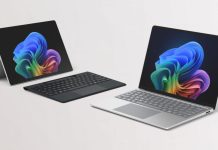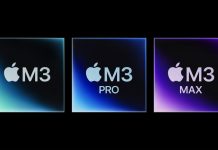Social mores aside, Vision Pro doesn’t seem designed to be used on the go.
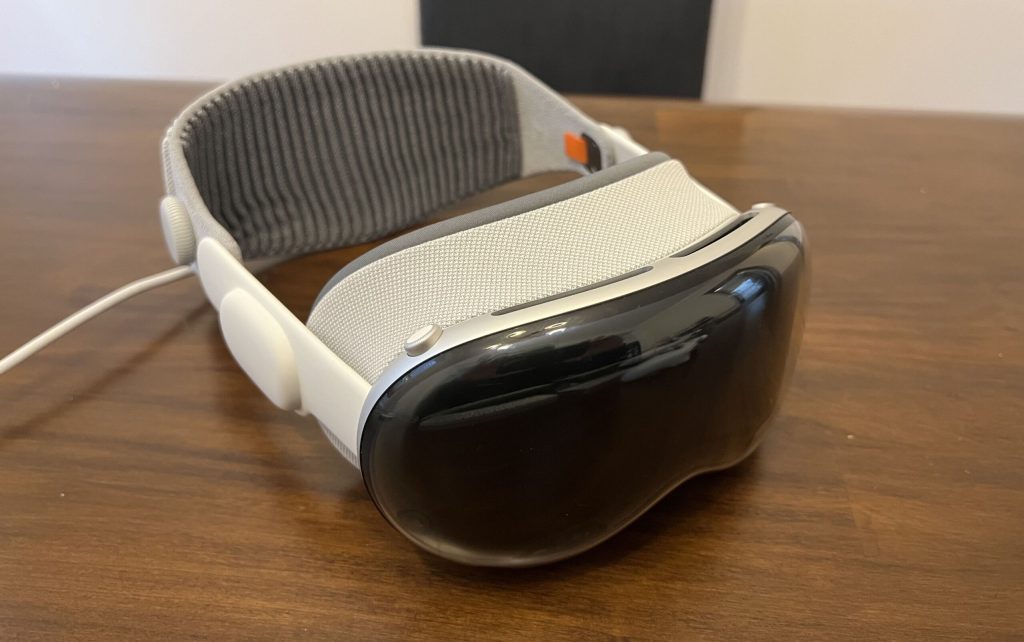
If you’ve spent any time in the tech-enthusiast corners of Instagram of TikTok over the past few weeks, you’ve seen the videos: so-called tech bros strolling through public spaces with confidence, donning Apple’s $3,500 Vision Pro headset on their faces while gesturing into the air.
Dive into the comments on those videos and you’ll see a consistent ratio: about 20 percent of the commenters herald this as the future, and the other 80 mock it with vehement derision. “I’ve never had as much desire to disconnect from reality as this guy does,” one reads.
Can a $3,500 headset replace your TV? We tried Vision Pro to find out
Over the next few weeks, I’m going all-in on trying the Vision Pro in all sorts of situations to see which ones it suits. Last week, I talked about replacing a home theater system with it—at least when traveling away from home. Today, I’m going over my experience trying to find a use for it out on the streets of Chicago.
I’m setting out to answer a few questions here: Does it feel weird wearing it in public spaces? Will people judge you or react negatively when you wear it—and if so, will that become less common over time? Does it truly disconnect you from reality, and has Apple succeeded in solving virtual reality’s isolationist tendencies? Does it provide enough value to be worth wearing?
ADVERTISINGAdvertisement
As it turns out, all these questions are closely related.
The potential of AR in the wild
I was excited about the Vision Pro in the lead-up to its launch. I was impressed by the demo I saw at WWDC 2023, even though I was aware that it was offered in an ideal setting: a private, well-lit room with lots of space to move around.
Part of my excitement was about things I didn’t see in that demo but that I’ve seen augmented reality developers explore in smartphone augmented reality (AR) and niche platforms like HoloLens and Xreal. Some smart folks have already produced a wide variety of neat tech demos showing what you can do with a good consumer AR headset, and many of the most exciting ideas work outside the home or office.
I’ve seen demonstrations of real-time directions provided with markers along the street while you walk around town, virtual assistant avatars guiding you through the airport, menus and Yelp reviews overlaid on the doors of every restaurant on a city strip, public art projects pieced together by multiple participants who each get to add an element to a virtual statue, and much more.
Of course, all those ideas—and most others for AR—make a lot more sense for unintrusive glasses than they do for something that is essentially a VR headset with passthrough. Nonetheless, I was hoping to get a glimpse at that eventuality with the Vision Pro.
The first trip out
I’d been using the Vision Pro at home and in my home office for hours a day, but those online videos and my previous exposure to the possibilities described above made it clear that I’d have to try wearing the device out somewhere.
It was the middle of a weekday that I mostly spent at home using the Microsoft Word app for the Vision Pro to write my article about the device’s entertainment applications. I live in a densely populated neighborhood on the north side of Chicago, and there are dozens of lunch and takeout spots in short walking distance, so it’s a frequent part of my routine to walk out to pick up something to eat and bring it home. That seemed like an ideal first test.
I wanted to start with something that was as casual as it could be. Fortunately, there’s a Potbelly sandwich shop only 600 feet from my doorstep.
I strapped the headset on with the solo loop band, dropped the battery in my left pocket, turned the knob to full passthrough, and started my way down the stairs of my building to the street.
The passthrough on this headset is better than anything I’ve seen before, and it’s more than enough to walk around while using it safely. No, it’s not anything close to the same as seeing the world with your own eyes, but you have all the fidelity and depth perception you need (and just barely enough field of view) to make it comfortable. Seeing what I was doing and navigating safely on foot was not a problem.
That said, there have been some videos of people driving with this thing on. That seems very unwise. The limited field of view could affect your ability to see vehicles in adjacent lanes, and the resolution is just low enough to pose a problem with seeing threats hundreds of feet away. Low-light visibility is poor, and there’s always the possibility that something in the software you’re using will go wrong, leaving your vision obstructed by a virtual object or, worse yet, making you totally blind, with no passthrough at all.Advertisement
While I felt safe walking with it on, wearing the Vision Pro while driving is unsafe and downright stupid. Just don’t do it.
To get to Potbelly, I must not only walk on my residential street, where I typically pass two or three people on the sidewalk, but I also have to make my way through a bustling nearby square where dozens of Chicagoans congregate. I was surprised that very few of these people reacted to me in any way. I got one cursory stare, but otherwise, my fellow pedestrians didn’t stop, didn’t say anything, and usually didn’t even look at me any more than they normally would any other stranger walking by.
That didn’t matter, though.
Yes, I felt ridiculous
Even though I didn’t see any outward evidence that others were judging me, I was judging myself. I felt self-conscious. I couldn’t shake the thought that even if the people around me weren’t saying anything negative, they were thinking it. Most Chicagoans are polite and keep to themselves on the street, but judgment is everywhere, even if you’re not wearing a hunk of glass and metal on your face.
I recalled the term “glassholes” from Google’s experiments with AR a few years back and wondered if that’s what people walking by thought of me. At a minimum, they probably thought I was an eccentric tech bro, I figured.
I arrived at Potbelly to pick up my order, which I’d placed via the chain’s iPhone app in advance. Normally, the bags of food are labeled with a name and left in a self-service pickup spot, but mine was still behind the counter. As a result, I had to go up to a worker and ask for it.
He interacted with me normally, looked me in the virtual eyes, made small talk with me, asked me a standard question about my order, and thanked me as he handed me the food. There was no awkward staring, no questions, no rude remark. That was a relief, but I considered that he may have held his tongue because I was a customer. I felt a drive to get through the interaction as quickly as possible to minimize my embarrassment.Advertisement
- In the right circumstances, you can see the eyes OK, though they look a bit faint and strange. Samuel Axon
- But a lot of the time, you can’t really make them out. Samuel Axon
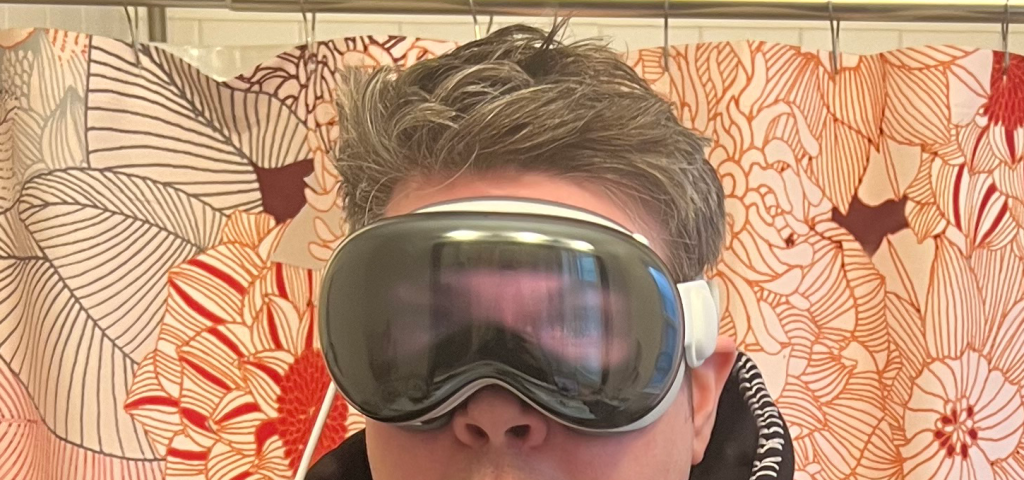
On the walk home, I still felt awkward, even though no one gave me any reason to. Maybe some Vision Pro users won’t care, but I couldn’t shake this feeling.
Those derisive TikTok comments I mentioned earlier had a common theme: Wearing the Vision Pro headset disconnects you from reality and the people around you, and that’s not desirable. More than one comment noted that people are already isolated enough with phones.
I’ll say this for the Vision Pro: I don’t think that line of thinking holds up in reality. The truth is that I was more aware of my surroundings and the people around me with the Vision Pro on than I would have been if I was constantly looking down at my phone. My eyes were always up and taking in what was in front of me. There was no chance I’d block the sidewalk or run into someone because I was too busy futzing with a tiny screen at waist level.
The Vision Pro doesn’t detach you from the people around you any more than a phone does—it’s actually an improvement in that regard. But it’s not normal, it’s not something people have seen before, and it’s hard to miss. It draws attention and makes you stand out. My gut was telling me that wasn’t in a good way, even though everyone around me was polite.
Social barriers remain
Plenty of people have said that VR headsets are too isolating for widespread adoption, and Apple put considerable effort into solving that problem for the Vision Pro. It’s where a lot of the design thought went, it accounts for several pieces of the device’s hardware (and cost), and it’s where a lot of the most substantial innovations are.
In some aspects, Apple has succeeded. For example, fully immersive VR commonly leads to people walking into objects and hurting themselves or breaking things. And headsets are an awkward barrier when a household member walks up to you to speak with you while you’re wearing one. You have to fumble with the controls to go to passthrough mode, or you have to take the headset off, futzing with wires and adjustments along the way.
In the Vision Pro, Apple has introduced a knob you turn to adjust your level of immersion, and it’s beautifully implemented. Furthermore, the Vision Pro’s external sensors can detect when a person walks up to you and fade them into view inside your immersive virtual environment without any input from you at all. Likewise, approaching an object in the physical world causes your view to fade away from immersion and toward passthrough as you approach it.
In these ways, Apple has solved several common problems with VR.
However, other efforts are less successful. EyeSight, the feature that shows a 3D representation of your gaze to those around you, seems like it needed some more time in the oven. It mostly succeeds at providing key social information to those around you (what you’re looking at, whether you’re paying attention to them, and so on). But it also looks… well, bizarre. The eyes are fuzzy and ill-defined, sometimes easy to see and sometimes not. And you have no feedback inside the headset about how you’re appearing to someone near you.
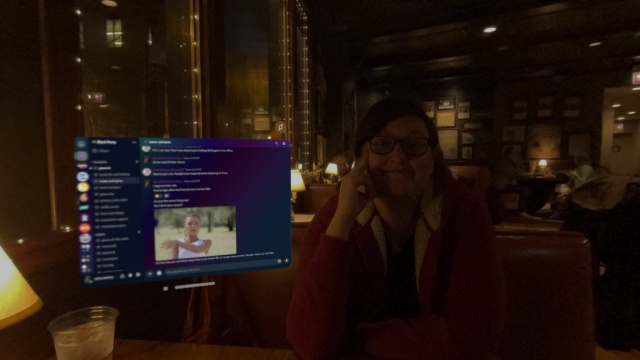
Later that evening, I went out to dinner with my wife at a local bar where we’re regulars and friendly with the staff. One person on staff had been asking me about the Vision Pro with enthusiasm in the weeks leading up to the launch, so I figured that was as safe a place to wear it as any.Advertisement
I slipped into a booth and put the headset on. The friend who often asked about the Vision Pro wasn’t working that night, unfortunately, but the waitress who took my order quickly became the first person to say something about me wearing the headset in public.
“Is that the new Apple thing?” she asked. I said yes. “And you can see me?”
I said yes again. “I can see your eyes; it’s kind of weird,” she added with a friendly laugh. I nodded in agreement. She took our order, then looked back at me briefly before walking away.
A few minutes later, another waiter came out with our food. He was placing my plate in front of me but seemed to take extra care, believing I couldn’t see him. When I took the plate in my hands, he seemed taken aback. “You can see in that thing?” he asked. “Yep,” I said. He shook his head in confusion and walked away.
As I had conversations with my wife with the Vision Pro on, I asked her how she felt about EyeSight. She said that while she could see why Apple thought it was worth a try, it’s so weird and inconsistent that it wasn’t worth it. It felt less weird to her to not see my eyes at all than to see them this way. (She also said my eyes were not in the right place on my face, making things even stranger.)
I’ll talk about EyeSight’s companion feature, Personas for video calls, in an upcoming article about productivity, but here’s a quick spoiler: They’re not good, either.
The biggest problem with wearing the Vision Pro in public, though, is that it’s not something people are used to seeing. Most people who have tried a VR headset have only tried one without passthrough, so they assume you’re not able to engage normally while you’re wearing it, even with EyeSight in place.
Of course, using smartphones in public—or even just good, old-fashioned cell phones—was also once alien. Those devices sparked similar conversations about people disconnecting from reality. So did headphones when the Walkman came along and when AirPods were introduced.
AirPods, like the Vision Pro, get a bad rap. One of their key features is that you can wear them while still being aware of sounds and voices around you, making them better for connection with others than most other headphones. But even now, not everyone thinks about them that way, and jokes abound about detached or aloof AirPods wearers. If even AirPods can’t overcome that stigma, I doubt the Vision Pro will do so anytime soon.
“Walking around” wasn’t an intended use case
We’ve already answered a few of our questions. Does it feel weird wearing the Vision Pro in public spaces? For me, yes. Will people judge you or react negatively when you wear it? Not usually, but you never know. Does it truly disconnect you from reality? Not really. Has Apple succeeded in solving VR’s isolationist tendencies? Only in some contexts and respects, but definitely not in all.
There’s one big question left, though: Does the Vision Pro provide enough value to be worth wearing? This, unfortunately, is a hard no.
That’s not because Apple failed here, though; it’s because it didn’t even try.
I didn’t mention this earlier, but I learned within seconds of leaving my home that there was no point to this exercise—at least the “walking around” bit.
The way the Vision Pro works is that you position windows and other virtual objects in specific places in 3D space. For example, you can put a TV screen on your wall or float your email app’s window in the middle of the room. You can even put widgets in different places around your house. Leave the room and come back, and they’ll still be there.
That’s really cool! It also makes the device unusable when walking around outside the home. When I opened the Music app to change songs while walking on the sidewalk, it worked—there it was, an Apple Music window floating in my neighbor’s yard. I switched songs and moved along—but the window stayed there. In fact, when I came back 10 minutes after completing my Potbelly trip, the window was still floating in my neighbor’s yard.
- I could use Apple Music while walking down the street… Samuel Axon
- …but I had to leave it behind as I walked. Samuel Axon

visionOS windows don’t stick to you; they stay in place. You can pinch to carry one as you go, but it gets a bit jittery, and you’re bound to lose it a couple of times.Advertisement
It’s obvious to me that, at least in this iteration, Apple didn’t even try to offer any value for using the Vision Pro out and about. Remember when I said that augmented reality directions could be a cool use case for AR goggles or glasses? Well, Apple didn’t even bother to add that as a feature. In fact, the Maps app for visionOS is in the “Compatible Apps” category—it’s literally the iPad app, exactly as you’d use it on an iPad Air, just running inside visionOS. There are no AR directions. There is no AR Maps app.
Across Apple’s library of first-party apps, there’s not a single one that has given any consideration to its design for on-the-go use. And I couldn’t find any in the App Store, either.
So, if you were considering taking a walk with the Vision Pro, save yourself the humiliation. There’s nothing to be gained by doing so.
Wearing the Vision Pro in a restaurant or bar could make sense in the right situation, though—I’d say it’s suitable to use it anywhere you’d feel comfortable pulling out a laptop. But, like a laptop, it’s not practical to use until you’ve found a spot and settled in.
None of those cool AR tech demos I’ve seen before have made their way to the Vision Pro. That doesn’t mean they couldn’t in the future, though.
For now, the Vision Pro finds some compelling uses at home, in the office, or in certain public spaces like coffee shops or airport lounges. If you really want to wear it while walking around, you can, but you’re inviting social judgment for no upside.
Maybe we’ll start to see some of those cool out-and-about applications when we finally get viable smart glasses more than a couple of years down the road.
The good
- No one made any mean remarks, attacked me, or robbed me
- Works well when settled into a restaurant booth or some other stationary position
- Passthrough quality was sufficient to make walking around safe, at least in terms of not getting hit by a car or bumping into anything
The bad
- I felt self-conscious while walking around (your mileage may vary)
- EyeSight is at least as uncomfortable as it is helpful
- No one knows how to react to this thing yet, and many people assume you can’t see
- There are few apps that benefit from use out in public, despite some promising experiences in mobile AR leading up to this point
The ugly
- visionOS’s stationary windows make it totally impractical to use while walking around—that’s just not an intended use case
Listing image by Samuel Axon

